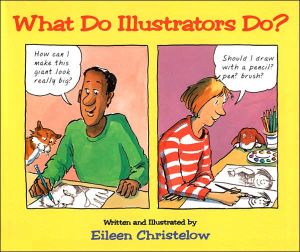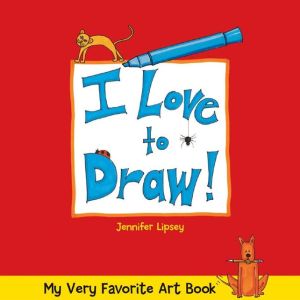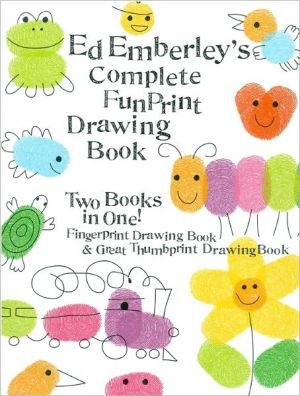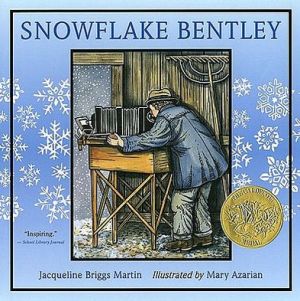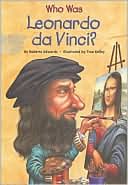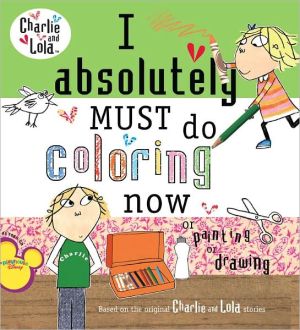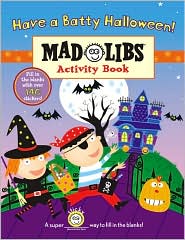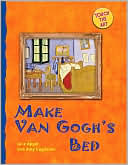What Do Illustrators Do?
In this informative companion to the popular "What Do Authors Do?" author/illustrator Christelow turns her attention to the visual side of creating a picture book. Employing her relaxed style and trademark humor, she shows how an illustrator develops a book from rough sketches to finished artwork, following two artists as they illustrate different versions of "Jack and the Beanstalk." Christelow answers the questions often posed by children, such as, "What materials do you use?" and "Is it...
Search in google:
In this informative companion to the popular "What Do Authors Do?" author/illustrator Christelow turns her attention to the visual side of creating a picture book. Employing her relaxed style and trademark humor, she shows how an illustrator develops a book from rough sketches to finished artwork, following two artists as they illustrate different versions of "Jack and the Beanstalk." Christelow answers the questions often posed by children, such as, "What materials do you use?" and "Is it hard to be an illustrator?" and reveals that the uniqueness of each book depends on many creative choices . . . and a lot of painstaking work.Eileen Christelow has created numerous fun and funny picture books, including the Five Little Monkeys series, Author, and most recently, Letters from a Desperate Dog. She and her husband, Ahren, live in Vermont. For more information visit www.christelow.com.Publishers WeeklyChristelow escorts readers behind the scenes for a fascinating peek at the creative process in this companion to What Do Authors Do? Here she tracks the efforts of two fictitious artists, showing their different approaches to illustrating the same story ("Jack and the Beanstalk" serves as the example). Christelow funnels information through a triple conduit: cartoon panels display the artists at work; a lively subplot features a dog and cat and their running commentary; and chunks of straightforward prose hold the visual elements together. For all the many components, the end result is cohesive and easy to follow, and the amount of material covered is impressive, e.g., how a picture book evolves, from dummy to finished product, and such concepts as scale, perspective and point of view. Medium is discussed and, more importantly, depicted in a concrete way; Christelow demonstrates how the same illustration would look if rendered in, say, pencil as opposed to felt-tip pen, or watercolor as opposed to colored pencil. The roles of editors and designers are also briefly touched upon. By alighting on a subject with which her audience has some familiarity, Christelow instantly engages interest, and by keeping the proceedings briskly informative and fun, she ensures that readers come away with a real appreciation of both the artistry and effort involved in illustrating books. Ages 5-8. (Mar.)
\ Publishers Weekly\ - Publisher's Weekly\ Christelow escorts readers behind the scenes for a fascinating peek at the creative process in this companion to What Do Authors Do? Here she tracks the efforts of two fictitious artists, showing their different approaches to illustrating the same story ("Jack and the Beanstalk" serves as the example). Christelow funnels information through a triple conduit: cartoon panels display the artists at work; a lively subplot features a dog and cat and their running commentary; and chunks of straightforward prose hold the visual elements together. For all the many components, the end result is cohesive and easy to follow, and the amount of material covered is impressive, e.g., how a picture book evolves, from dummy to finished product, and such concepts as scale, perspective and point of view. Medium is discussed and, more importantly, depicted in a concrete way; Christelow demonstrates how the same illustration would look if rendered in, say, pencil as opposed to felt-tip pen, or watercolor as opposed to colored pencil. The roles of editors and designers are also briefly touched upon. By alighting on a subject with which her audience has some familiarity, Christelow instantly engages interest, and by keeping the proceedings briskly informative and fun, she ensures that readers come away with a real appreciation of both the artistry and effort involved in illustrating books. Ages 5-8. (Mar.)\ \ \ \ \ Children's LiteratureFollowing her much acclaimed book, What Do Authors Do?, Christelow has once again managed to pack a great deal of information into a most enjoyable book. This time she has tackled the children's book illustrator's job. In fact the title really should be What Do Children's Book Illustrators Do? because most illustrators also do posters, cards, menus, fashion, and other printed materials as well as books. But the thorough approach to the whole process of illustrating a picture book will help many future illustrators. The book follows two illustrators who just happen to be illustrating the same fairy tale. This is a lovely concept. Children see how two people can interpret the same basic story with such vastly different results. One illustrator has a pet cat and the other a dog and these two animals maintain a running commentary about the progress of their owner's artwork. The book shows where an illustrator might work, how they plan a book, make a dummy book, work out the preliminary sketches, make mistakes, see different points of view, solve problems with the illustrations, work out perspective, design each page, use a model, compare different illustration styles and materials, talk with editors and publishers, and finally, celebrate the completed book.\ \ \ Library JournalK-Gr 3-In this companion to What Do Authors Do? (Clarion, 1995), Christelow gives readers a great deal of insight into the creative process while entertaining them with a story (actually two) within the story that tells the story of how picture-book artists work. Two illustrators share studio space and, as it turns out, each one of them sets out independently to create a new version of "Jack and the Beanstalk." Readers are clued into the situation and the various choices and dilemmas facing the artists by their pets, the woman's dog Scooter and the man's cat Leonard. In breezy but informative conversations, the animals discuss the deliberations and determinations about the books' sizes and shape, concepts such as point of view and perspective, and decisions about typeface and medium. In addition to the brief text, the pages are filled with cartoon panels, dialogue balloons, and spot drawings. The pen-and-ink and watercolor drawings are expressive and engaging throughout. Children will come away from this effort with a bit of knowledge about how books are made and an appreciation for the hard work and talent involved in telling a story through pictures. Better than a magic bean, this title is sure to spark youngsters' curiosity and creativity, and when that happens-as everyone knows-the sky's the limit.-Luann Toth, School Library Journal Copyright 1999 Cahners Business Information.\ \ \ \ \ BurnsThe two...characters are appealing; their individual creative experiences are related humorously and informatively without being didactic. Here is one introduction to a specific profession that entertains as it instructs; it should not be restricted to te elementary-school-age children for whom it is intended.\ — The Horn Book Magazine\ \ \ \ \ Kirkus ReviewsAs breezy and enlightening as its companion, What Do Authors Do? (1995), this volume takes readers behind the scenes to watch two (fictional) artists create picture-book editions of Jack and the Beanstalk. Between the first flash of inspiration and celebratory ice cream cones at the end, both illustrators sketch dummies; make decisions about character, perspective, point-of-view, and composition; experiment with different media; and entertain tactful suggestions from editors and designers. Meanwhile, each takes the story in a different direction, one sticking to tradition, the other switching to an all-female cast. Around and within the cartoon panels, pets and a child add explanatory comments to the captions. Although she only hints at the amazing diversity of today's illustrators, Christelow captures the effort that goes into the making of picture books while also answering many of the questions children ask on the subject. (Picture book. 6-9) .\ \ \ \ \ From the Publisher"Jaunty in tone, informative in content, and, with its comic-book-style presentation, accessible in format, this is a fitting companion to Christelow's What Do Authors Do? . By featuring two fictional artists-one male and one female-each inspired to retell and illustrate "Jack and the Beanstalk," Christelow not only explains the process of bookmaking but also defines abstract concepts (style, design) with as much clarity as more concrete technical terms (dummy, typeface). The choice of story for analysis is particularly fortuitous: it is familiar to the intended audience; it has the potential for depicting a wide range of emotions; and it can be adapted to alterations-such as changing the gender of the protagonist-while still retaining basic elements. Discussion of the many ways in which these elements can be portrayed affords insight into the whole process of bookmaking: working within the constraints of a picture-book format, avoiding the perils of page design (especially losing art in the gutter), and selecting the appropriate medium and technique for realizing an idea. The two artist characters (and their voluble pets) are appealing; their individual creative experiences are related humorously and informatively without being didactic. Here is one introduction to a specific profession that entertains as it instructs; it should not be restricted to the elementary-school-age children for whom it is intended." Horn Book\ "As breezy and enlightening as its companion, What Do Authors Do? (1995), this volume takes readers behind the scenes to watch two (fictional) artists create picture-book editions of Jack and the Beanstalk. Between the first flash of inspiration and celebratory ice cream cones at the end, both illustrators sketch dummies; make decisions about character, perspective, point-of- view, and composition; experiment with different media; and entertain tactful suggestions from editors and designers. Meanwhile, each takes the story in a different direction, one sticking to tradition, the other switching to an all-female cast. Around and within the cartoon panels, pets and a child add explanatory comments to the captions. Although she only hints at the amazing diversity of today's illustrators, Christelow captures the effort that goes into the making of picture books while also answering many of the questions children ask on the subject." Kirkus Reviews\ "In this companion to WHAT DO AUTHORS DO?, Christelow gives readers a great deal of insight into the creative process while entertaining them with a story (actually two) within the story that tells the story of how picture-book artists work. . . . Better than a magic bean, this title is sure to spark youngsters' curiosity and creativity, and when that happens-as everyone knows-the sky's the limit." School Library Journal, Starred\ \ \
